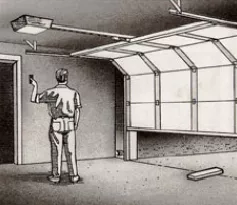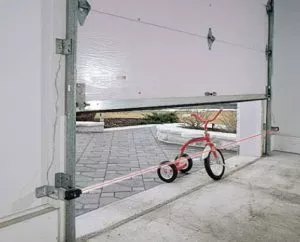Like most things, garage doors just need a little tiny bit of care to ensure optimum operation for decades to come. We’re not talking hours and hours of work, just 10 minutes every three months, and there are only four things that you really need to check regularly.
Let’s find out what they are…
Visually Inspection
By far the easiest thing you’ll be doing. Go inside your garage, and close the garage door. You need to check how the garage door system works.
- Do the rollers look okay? Are they worn out? Are they sliding rather than rolling?
- What about the lifting cables, are they still intact? Not frayed at all?
- Now check the torsion spring (if you have one it’ll be above the door), is it broken?
- And what about the extension springs (above the horizontal tracks)? Are they hanging down or is everything in place?
- Finally, can you see any screws or bolts that need tightening up?
Check if the door is properly balanced
As I’m sure you’re probably aware, the spring system on your garage door acts as a counterweight to ensure the door is properly balanced and won’t cause any injuries. A properly balanced door should have a perceived weight of just 8‑10 lbs, i.e. you should be able to open it one-handed.
To check if the door is balanced, pull on the red emergency release cord to deactivate your electric door open. Then try and open the garage door manually. If all is going well, leave it open about 4 feet off the ground. Does the door hold its position?
If you either can’t open the door one-handed or the door doesn’t stay in position when you open it halfway, the spring system isn’t working. It’s absolutely essential that you call a garage door professional and have them inspect the door as soon as possible to avoid serious injury.
Is the MECHANICAL Reversal system working?

The mechanical reversal system on your garage door prevents the door from closing on something that’s in its way. For example, if you place a piece of lumber in the door’s path, it should automatically reverse and open if it comes into contact with it: It’s a really important safety feature.
It’s easy to verify, just put a piece of lumber in the door’s path and close the garage door, if it doesn’t automatically reverse and open, you’ll need to adjust the door opener’s sensitivity. Again, this is a simple task, you need to turn the limit adjusting screws (on the side of the opener housing) a quarter turn counterclockwise, then retest the door. If the door still doesn’t automatically reverse when it comes into contact with the wood, turn the screws another quarter turn, and another, and another… Until the mechanical reversal system works as it should.
Is the PHOTO‑EYE Reversal system working?

This is another important safety feature. Unlike the mechanical system, the photo‑eye reversal system detects items in the way before the door comes into contact with them through the light beams (invisible to the naked eye) on the side of each door. If your garage door was manufactured in 1993 or later in North America, it will be equipped with this system.
To check it’s working, simply pass your hand or foot in front of one of the two light beam units to break the beam. They should detect your presence and the door should automatically open. If it doesn’t one of the units is likely misaligned or a wire between the unit and the door opener is likely broken.
If you think your door needs tuning up
Call us at 1-877-545-3667, we have a tune‑up program that will ensure your garage door is back in top working order in no time. We can also help you if you’re thinking about changing your garage door, we’ll be happy to either send you a quotation or come out to your home to show you the different types of models available and find the best fit for you.
Unsure what kind of style to go for? Browse our image gallery for inspiration and then ‘try on’ a garage door using our Design Centre tool.

Add new comment